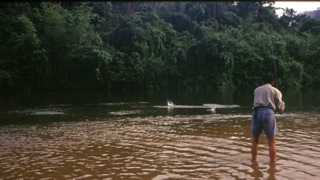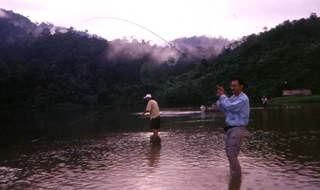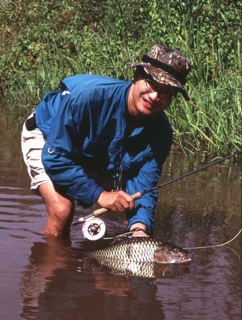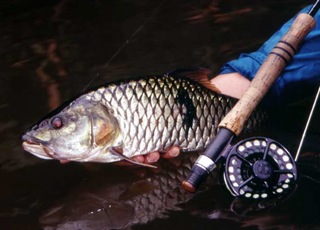
Going deep
There is nothing like sitting out in the open, lounging in a comfortable camp chair with the gentle gurgle of the water flowing at our feet. Relaxing after a satisfying dinner, and sipping a warm drink to nullify the chill of the cool breeze blowing off the hills, all these creature comforts enhances one's appreciation of the scenery beneath the glittering stars. The lustrous rising full moon lights the surroundings with a silvery aura, giving the area a blissful ambience. What more can one wish for to end a pleasant fish filled day?
Slipping out of the sleeping bag into the cool morning air, we were greeted by the sight of the setting moon - continuing to illuminate the quiet surroundings. As it was still early we took our time during breakfast to enjoy the serenity that comes before dawn. Getting away from the fast paced city life to the peaceful mountains soothes the spirit and mind. Thank goodness there still are places in Malaysia where "development" and "eco-tourism" have yet to arrive.
My intention for the day was to put in some serious effort into catching some sebarau on fly. Catching a fish on fly gear is extremely thrilling as it is very much a hands on style of fishing. This is due to the way the line is handled by hand on the retrieve, hook-up and at times during the fight. The evening before I had prepared the fly gear for today's attempt, rigging up my 5 and 6 weight fly gear.
With the moon disappearing over the horizon and the sky lightening to the east we got into the boat and cruised out to our favourite river-mouth. Often the sebarau bite may be at first light, sometimes for only an hour, until the sun hits the water. At other times it can be as short as only fifteen minutes during the period of dawn. On very rare occasions, it can last the whole day.
Alas, there was no action at all in the early morning. The surface waters remained quiet and the waters beneath only yielded one sebarau. It was a bit of a disappointment as I had come with a big array of new flies to test out. Previously I had noted that the main forage of the sebarau here was a tiny baitfish just over 3cm in length. It had a translucent body with the shiny lateral line or the backbone clearly visible. The silvery stomach pouch and head were the only body parts that were not translucent.
I had been scouting around for some suitable fly material that would help me mimic this baitfish, and during my trout trip to New Zealand some prospective looking fine and soft fibres were found and purchased. The initial 2 prototypes I had tied, worked on the sebarau near Klang Valley but I found the pattern I used rather time consuming to tie. Just before this trip I decided to experiment a bit more and came up with some new patterns that were simpler to tie. All of them were attempts to mimic the little translucent baitfish, either to give the impression of the baitfish or to imitate its dominant visual characteristics. That is the advantage of being a fly tier, we can "invent" our own patterns to mimic the local baitfish.
This trip was the test, to see whether they would work, and which would work best and consistently. There is no doubt there are a large number of fly patterns that would work but with a variety of patterns I could narrow down the more effective patterns.
Moving up river we continued our search for fish on fly unsuccessfully. Deciding to go back down some distance, we came to a quiet bay where we noticed some gentle swirls and splashes, sometimes individually and at other times in a shoal. Unsure of the fish species stirring the water, we quietly motored into the area and began casting. Initially I used a floating fly line and did not get any takers. Later I felt a nudge and slowly retrieving the line with a gentle stop and go technique I felt a few more dainty taps. When the fly came into view I could see sebarau following my fly, then turning away when it saw the boat.
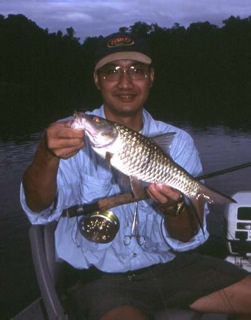 Obviously some of those rising fish were sebarau, but they were not viciously slashing at the baitfish, a visual sight we are more familiar with. The surface action would occur only occasionally and some of them seemed more subsurface than right at the surface. The echo sounder showed there were lots of fish at the deeper levels in the water column. Most of the fish were below the 3.5 metre mark right down to the bottom which was between 8 and 15 metres deep.
Obviously some of those rising fish were sebarau, but they were not viciously slashing at the baitfish, a visual sight we are more familiar with. The surface action would occur only occasionally and some of them seemed more subsurface than right at the surface. The echo sounder showed there were lots of fish at the deeper levels in the water column. Most of the fish were below the 3.5 metre mark right down to the bottom which was between 8 and 15 metres deep.
Fishing with a floating line would not get the fly deep, as the retrieval of the fly would always bring it up near the surface. Maybe the deepest I was fishing the fly would be the 2 metre zone. Changing to a sinking fly line I tied on a heavily weighted fly, which would work the deeper water column and hopefully produce more fish.
Sinking lines for fly fishing are not like heavy metal jigs that plummet down; they sink slowly. The better fly lines are categorised by sink rate in inches per-second. A slow sink line would sink at 2-3 inches per-second whereas a fast sink line would sink between 5-7 inches per-second. The sinking line I was using was a budget one and was not classified, but it seemed to sink at a moderate speed of maybe 3 inches per second so it would take more than 10 seconds to sink a metre. Thus to get the fly below the 3 metre mark I would have to wait more than half a minute.
It turned out that this was the trick to success. Now that I was able to consistently hook up the sebarau, I could begin to experiment with the different flies I had tied for the trip. As they all were intended to mimic the baitfish commonly found there, it was not surprising they all caught fish, though some seemed to more effective than others.
The more effective ones were a pretty close match to the real thing, though not imitating the baitfish completely, more of an impressionistic fly type pattern. These patterns also were successful in catching a number of river lampam that were actively feeding as well.
All the fish, the sebarau and lampam preferred the slow twitch retrieve, often taking the fly on the stop of the retrieve. The biggest sebarau of the trip was taken on this method on one of the more choice patterns.
It was a catch to remember. A gentle take that felt like any other sebarau with the normal short run. The second run however was quite different when I found all my shooting line disappearing out of the basket and my index finger holding the line starting to smoke. Well almost, it did get burned a little though.
With the line now on the reel, I was able to fight the sebarau, using the reel instead of playing with the line by hand, which was more comfortable than getting a groove burnt through my fingers. Those who are used to fighting a fish with a conventional reel will find that a fly reel is different. Unlike a conventional reel, when the fish runs, the fly angler will have to release the handle, and it will spin fast. So the fingers are kept clear of the painful knuckle rapping little handle. Only when the run stops is the handle grasped again to turn the reel. This is known as a direct drive reel.
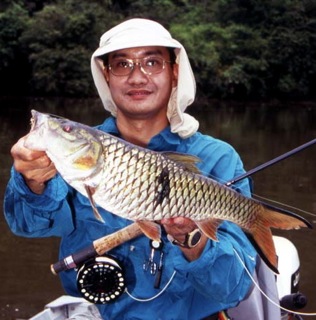 I had my nice little share of fun, slowly recovering the line and then when I felt it surge, releasing the handle, letting it run against the reel's light drag and then recovering the line when it stopped running. The bay was not a snaggy zone so I could let it run where it pleased, around and under the boat and out again. After 5 minutes of fun, it was finally brought in to the net. A nice trophy sebarau on fly.
I had my nice little share of fun, slowly recovering the line and then when I felt it surge, releasing the handle, letting it run against the reel's light drag and then recovering the line when it stopped running. The bay was not a snaggy zone so I could let it run where it pleased, around and under the boat and out again. After 5 minutes of fun, it was finally brought in to the net. A nice trophy sebarau on fly.
For those who wonder why there is no mention or pictures of my fishing partner, well it is because this article is about fly fishing and my partner was not fly fishing. Lest it be questioned which method was more successful, I would like to avow that the biggest sebarau caught there was on a tiny 2 cm fly. Fly Fishing RULES!
Conservation
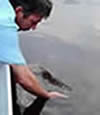
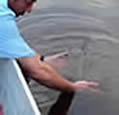
We need to protect and conserve our resources by practising catch and release of our sportfish and protecting the habitat of our fishes.
